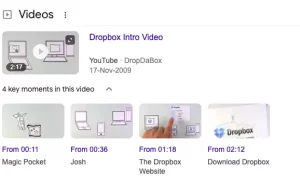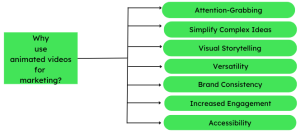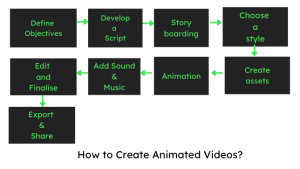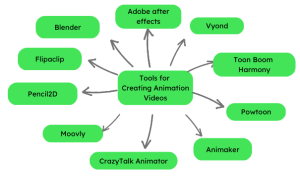How to Create Animation Video?
It is expensive to create animation videos. They deliver your message faster and clearer.
Animation is about simplifying concepts and explaining the concept in high quality visuals.
Stats state that viewers retain 95% of a message when they watch a video for it. 59% of marketers use animated videos to sell their products and services.
If you are looking for smart and memorable marketing for your brand, try with animated videos making.
Read more about it .
What are animated videos?
Animated videos are a form of visual media that uses animation techniques to bring characters, objects, and scenes to life. They are created by sequencing a series of still images or drawings to create the illusion of movement. These videos can be made using various methods, including traditional hand-drawn animation, computer-generated animation, and stop-motion animation.

Animated videos can be found in various formats and styles, such as cartoons, anime, 3D animation, motion graphics, and whiteboard animations. They are often used in storytelling, entertainment, education, marketing, and communication.
One of the advantages of animated videos is their ability to portray complex ideas, concepts, and narratives in a visually engaging and accessible manner. They allow for creative expression, imaginative visuals, and the depiction of scenarios that may be challenging or impossible to capture using live-action videos.
Animated videos can appeal to audiences of all ages and are commonly used in children’s entertainment, where colourful characters and vibrant visuals entertain and educate young viewers. However, animated videos are not limited to children’s content and are also widely used in various industries, including advertising, film, television, video games, and online media.
Animated Videos Brand Example
GoPro is an excellent brand example of video production. With their rugged and versatile cameras, they have revolutionised the way people capture and share their adventures.
GoPro’s videos showcase thrilling moments in extreme sports, outdoor activities, and travel, all shot from unique perspectives. Their high-quality footage and dynamic editing have made GoPro a leader in the action camera industry and inspired a global community of content creators.

- Dropbox

Dropbox is a cloud storage service that allows users to store and share files and documents across different devices and platforms. They have utilised animated videos in their marketing campaigns to showcase the features and benefits of their service in a visually engaging and informative way.
These videos often employ colourful and dynamic animations to demonstrate how Dropbox can simplify file storage, collaboration, and sharing processes for individuals and businesses.
Why use animated videos for marketing purposes?
There are several reasons why animated videos are commonly used for marketing purposes:

- Attention-grabbing: Animated videos can capture viewers’ attention with their visually appealing and dynamic nature. The vibrant colors, lively characters, and engaging animations can stand out in a crowded marketing landscape and help to grab the audience’s attention.
- Simplify complex ideas: Animated videos effectively simplify and explain complex ideas, concepts, or products. They can break down intricate information into digestible and easily understandable visuals, making it easier for viewers to grasp and retain the key messages.
- Visual storytelling: Animation allows creative storytelling techniques that evoke emotions and connect with viewers emotionally. By using animated characters, settings, and narratives, brands can create compelling stories that resonate with their target audience, helping to build brand awareness and loyalty.
- Versatility: Animated videos offer many possibilities regarding style, design, and creative execution. They can be tailored to match a brand’s identity and message and adapted to various platforms, including websites, social media, and presentations.
- Brand consistency: Animated videos provide an opportunity to maintain consistency in brand messaging and visuals. The animation’s characters, colours, and overall style can be aligned with the brand’s existing marketing materials, ensuring a cohesive and recognizable brand identity.
- Increased engagement and sharing: Animated videos are highly shareable and have the potential to go viral. Their entertaining and visually appealing nature encourages viewers to share them with others, increasing brand exposure and reach.
- Accessibility: Animated videos can transcend language and cultural barriers, making them accessible to a global audience. They can effectively communicate messages without relying heavily on spoken or written language, making them inclusive and suitable for diverse target markets.
Also Read : How to Use Video Marketing for SEO
How to create animated videos?
Creating animated videos involves several steps. Here’s a general overview of the process:

- Define your objectives: Determine your animated video’s purpose, message, and target audience. Clarify what you want to achieve and the key points you want to communicate.
- Develop a script: Write a script that outlines your video’s narrative, dialogue, and actions. Ensure that it aligns with your objectives and effectively conveys your message.
- Storyboarding: Create a storyboard, a visual representation of the video’s sequence. Sketch each scene, including the characters, backgrounds, and critical actions. This step helps in planning the flow and visual composition of the video.
- Choose a style: Decide on the visual style and animation technique you want to use for your video. It can be hand-drawn, 2D digital animation, 3D animation, motion graphics, or a combination of different styles.
- Create assets: Based on your storyboard, create the necessary assets, such as characters, objects, backgrounds, and props. This can involve drawing, designing, or creating digital assets using graphic design or animation software.
- Animation: Use animation software or tools to bring your assets to life. Depending on the chosen style, you may animate the characters and objects frame by frame or use keyframe animation techniques. Pay attention to timing, movement, and transitions to ensure smooth and visually appealing animations.
- Add sound and music: Enhance your animated video by incorporating appropriate sound effects and background music. This can help set the mood, emphasise actions, and engage the audience. You can use royalty-free music and sound libraries or hire a composer to create original music.
- Edit and finalise: Once the animation and sound elements are complete, edit the video to refine the timing, transitions, and overall coherence. Adjust the visuals, audio, and pacing for a polished final product.
- Export and share: Export the animated video in a suitable format and resolution for your desired platforms (e.g., MP4 for online sharing). Consider optimising the video for web or mobile viewing. Share your video on relevant platforms like your website, social media channels, or video hosting platforms.
Tools For Creating Animation Video
Here are some tools you can use to create animation videos:

- Adobe After Effects: A powerful industry-standard tool for creating motion graphics and animations with many features and effects.
- Vyond: A user-friendly platform for creating animated videos with pre-built templates and characters, suitable for businesses and educational purposes.
- Toon Boom Harmony: A professional 2D and 3D animation software, offering advanced features and flexibility.
- Blender: An open-source 3D animation software that’s versatile and can be used for various types of animations, from simple to complex.
- Powtoon: A web-based platform that allows you to create animated videos and presentations using drag-and-drop elements.
- Animaker: An online tool with various animation styles, characters, and templates, making it suitable for different video needs.
- CrazyTalk Animator: A software that focuses on creating animations with 2D characters, suitable for beginners and professionals.
- Moovly: An online animation tool that offers a library of assets and a simple interface to create engaging animated videos.
- Pencil2D: An open-source software for traditional 2D hand-drawn animation, suitable for artists looking for a digital platform.
- FlipaClip: An app designed for creating animation on smartphones and tablets, useful for simple animations and storyboarding.
Conclusion
Creating animated videos is a dynamic and engaging process. Follow these steps: define objectives, script the narrative, storyboard the sequence, choose a style, develop assets, animate using software, and add sound. Seek professional assistance if needed. Ready to create captivating animated videos?
Reach out to hello@noboruworld.com or book a call and unlock the power of animated storytelling for your brand. Let’s bring your ideas to life through the magic of animation!
FAQ
What is the benefit of using animated videos for marketing?
Animated videos grab attention, simplify complex ideas, facilitate storytelling, maintain brand consistency, increase engagement, and have global accessibility.
How long does it take to create an animated video?
The time required to create an animated video varies depending on length, complexity, style, and resources. It can range from a few days to several weeks or more.
Do I need technical skills to create animated videos?
While technical skills can be helpful, user-friendly animation software and tools are available that require little to no coding knowledge. Additionally, outsourcing to professionals is a viable option.
How much does it cost to create an animated video?
The cost depends on duration, complexity, style, quality, and whether you create it in-house or hire professionals. Getting quotes or discussing budgets with animation studios or freelancers is best.
Can animated videos be used for educational purposes?
Absolutely! Animated videos are widely used in educational settings to explain concepts, engage students, simplify complex topics, and make learning more enjoyable and interactive.
What file formats are suitable for sharing animated videos online?
Commonly used formats for sharing animated videos online include MP4, MOV, and WebM. These formats are compatible with most video platforms and can be easily streamed or downloaded.
How can I measure the success of an animated video in my marketing campaign?
Key performance indicators (KPIs) for measuring success may include video views, engagement metrics (likes, comments, shares), conversions, click-through rates, and overall campaign performance.



